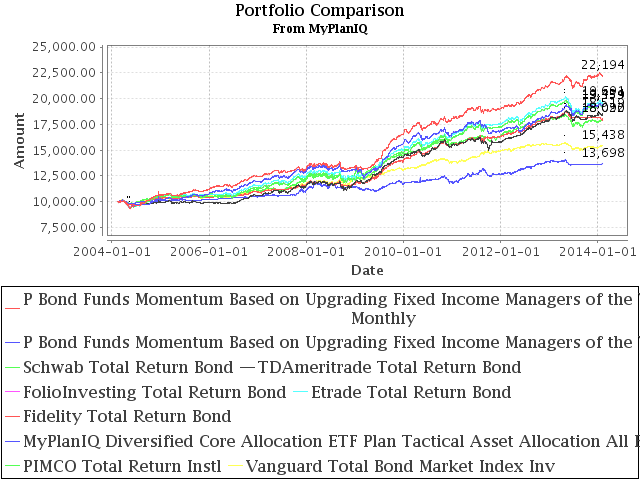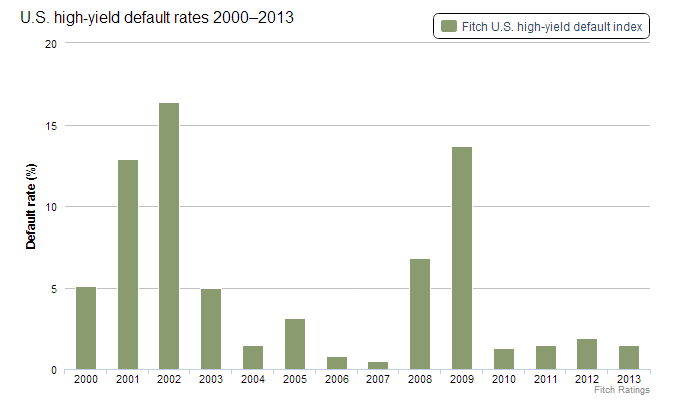Re-balance Cycle Reminder All MyPlanIQ’s newsletters are archived here.
For regular SAA and TAA portfolios, the next re-balance will be on next Tuesday, February 18, 2014. You can also find the re-balance calendar for 2013 on ‘Dashboard‘ page once you log in.
As a reminder to expert users: advanced portfolios are still re-balanced based on their original re-balance schedules and they are not the same as those used in Strategic and Tactical Asset Allocation (SAA and TAA) portfolios of a plan.
Please note that we now list the next re-balance date on every portfolio page.
Total Return Bond Fund Upgrade Portfolios
As many might have known, MyPlanIQ has maintained portfolios that invest in one of the top performing mutual funds managed by managers who have won Morningstar’s Managers of the Year award in fixed income. These mutual funds are either total return bond funds or multi-sector bond funds. Managers of such funds have flexibility to invest in any bond sectors including high yield and emerging market bonds.
P Bond Funds Momentum Based on Upgrading Fixed Income Managers of the Year`s Funds Monthly and a quarterly rebalance one are listed on Advanced Strategies page. However, we made brokerage specific and low minimum portfolios available to our basic subscribers last year. They are listed on Fixed Income Bond Fund Portfolios.
Morningstar recently announced its fixed income manager of the year for 2013. Daniel J. Ivascyn and Alfred T. Murata of PIMCO Income (PIMIX (PIMCO Income Instl) or PONDX (PIMCO Income D)) won the award. It is interesting to see that in addition to PIMCO Income, managers of Dodge & Cox Income (DODIX), Loomis Sayles Bond (LSBRX) and Metropolitan West Total Return Bond (MWTRX) were also nominees for the award. All of these fund managers won the award before. This is yet another strong indication that fixed income managers exhibit more consistent performance trend.
As a result, we are adding PONDX to the list of candidate funds in all of portfolios mentioned above. Fortunately, all of the brokerages we support have PIMCO Income fund available as a no load and no transaction fee fund.
Let’s first review how the candidate funds in P Bond Funds Momentum Based on Upgrading Fixed Income Managers of the Year`s Funds Monthly did last year.
Performance Comparison (as of 2/7/2014):
| Ticker/Portfolio Name | YTD Return** |
2013 | 3Yr AR | 5Yr AR | 5Yr Sharpe | 10Yr AR | 10Yr Sharpe |
|---|---|---|---|---|---|---|---|
| PTTDX (PIMCO Total Return D) | 1.6% | -2.9% | 4.4% | 6.7% | 1.75 | 5.8% | 1.11 |
| PBDDX (PIMCO Investment Grade Corp Bd D) | 1.6% | -5.1% | 6.4% | 9.8% | 1.86 | ||
| PONDX (PIMCO Income D) | 1.1% | 4% | 10.4% | 14.3% | 3.55 | ||
| TGLMX (TCW Total Return Bond I) | 1.3% | 1.4% | 6.5% | 9.7% | 3.16 | 6.9% | 1.56 |
| WATFX (Western Asset Core Bond I) | 1.7% | -2.1% | 4.6% | 9.9% | 2.34 | 4.5% | 0.67 |
| MWTRX (Metropolitan West Total Return Bond M) | 1.3% | -0.5% | 5.8% | 9.1% | 2.52 | 6.1% | 1.24 |
| LSBDX (Loomis Sayles Bond Instl) | 0.4% | 4.6% | 7.7% | 13.9% | 2.77 | 7.8% | 1.21 |
| DODIX (Dodge & Cox Income) | 1.5% | -0.2% | 4.9% | 7.3% | 2.6 | 5.2% | 1.32 |
| FPNIX (FPA New Income) | 0.5% | -0.1% | 1.7% | 2.1% | 1.82 | 3.1% | 1.56 |
**YTD: Year to Date
Year by year detailed comparison >>
Loomis Sayles Bond did well last year because of its exposure in high yield bonds. The fund can take more risk than other funds. Since 1996, this active approach has paid off handsomely. It achieved 9.1 annualized return since 6/20/1996. It did 7.8% in the last 10 years, much higher than the second ranked TCW Total Return Bond.
However, this approach did back fire in 2008. LSBDX had -21.8% loss in that year. This is compared with PIMCO PTTRX’s 4.8% or -1.5% of MWTRX.
Similarly, PIMCO’s Income fund did well in 2013, mostly because of its exposure in non-agency Mortgage Backed Securities and high yield bonds. The fund started in 2007 and had a -5.5% loss in 2008.
It is thus important to monitor and control the exposure of these funds. We feel our once a month monitoring, filtering or upgrading approach is a viable way to enable us to gain these managers’ services while in the meantime controlling the risk that some of these managers can under perform (sometimes dramatically) in some periods.
Here is the performance for these portfolios:
Portfolio Performance Comparison (as of 2/7/2014):
| Ticker/Portfolio Name | 1 Week Return* |
YTD Return** |
1Yr AR | 1Yr Sharpe | 3Yr AR | 3Yr Sharpe | 5Yr AR | 5Yr Sharpe | 10Yr AR | 10Yr Sharpe |
|---|---|---|---|---|---|---|---|---|---|---|
| Schwab Total Return Bond | 0.8% | 0.5% | 0.2% | 0.03 | 5.6% | 1.48 | 9.7% | 2.16 | 6.9% | 1.19 |
| Fidelity Total Return Bond | 0.8% | -0.4% | -0.2% | -0.13 | 5.3% | 1.94 | 8.9% | 2.42 | 6.1% | 1.39 |
| TDAmeritrade Total Return Bond | 0.8% | 0.5% | 2.2% | 0.54 | 6.1% | 1.51 | 9.1% | 2.07 | 6.4% | 1.12 |
| FolioInvesting Total Return Bond | 0.8% | 0.5% | 0.2% | 0.03 | 5.6% | 1.48 | 9.7% | 2.16 | 6.9% | 1.19 |
| Etrade Total Return Bond | 0.8% | 0.5% | 0.2% | 0.03 | 5.6% | 1.48 | 9.6% | 2.16 | 7.1% | 1.24 |
| P Bond Funds Momentum Based on Upgrading Fixed Income Managers of the Year`s Funds Monthly | -0.1% | -0.4% | 3.0% | 0.7 | 7.0% | 1.78 | 10.8% | 2.49 | 8.3% | 1.58 |
| P Bond Funds Momentum Based on Upgrading Fixed Income Managers of the Year Quarterly | 0.7% | 0.4% | 4.3% | 1.02 | 5.0% | 1.22 | 8.4% | 1.76 | 6.9% | 1.21 |
| MyPlanIQ Diversified Core Allocation ETF Plan Tactical Asset Allocation All Bonds | 0.3% | 0.7% | -1.7% | -0.85 | 4.7% | 1.3 | 4.1% | 0.87 | 3.2% | 0.51 |
| PTTRX (PIMCO Total Return Instl) | 0.4% | 1.6% | -0.1% | -0.03 | 4.8% | 1.38 | 7.0% | 1.82 | 6.1% | 1.18 |
| VBMFX (Vanguard Total Bond Market Index Inv) | 0.0% | 1.3% | -0.3% | -0.11 | 3.8% | 1.07 | 4.7% | 1.22 | 4.4% | 0.83 |
* YTD: Year To Date
Year by year detailed comparison >>
Notice that our brokerage specific portfolios in the above table have been doing as well as the ‘free’ style (non-brokerage specific) P Bond Funds Momentum Based on Upgrading Fixed Income Managers of the Year Quarterly. These brokerage specific portfolios take the mutual funds’ redemption limit (i.e. minimum holding periods) imposed by the funds and the brokerage into account. In the TDAmeritrade case, for example, all of the bond funds have 6 month minimum holding period restriction set. These brokerage specific portfolios are thus practical and can be readily used in these brokerages (we again remind our users that to mirror a portfolio in your brokerage account, please customize a model portfolio instead of simply following an existing one so that your account is in sync with the model portfolio in terms of holding periods).
In the table, we also compare the total return portfolios with the all bond portfolio constructed from MyPlanIQ Diversified Core Allocation ETF Plan. The portfolio did reasonably well but it lagged behind the total return bond portfolios. This again supports our position that upgrading among a list of excellent total return bond funds is a reliable way to achieve superior fixed income returns. One can also see that these portfolios even did better than PIMCO total return bond fund, a fund that had one of the best records in the past 10 years or so.
High yield bonds remain to be a bright spot
In November 25, 2013: Downtrend of Bond Market in Place, Will It Continue?, we discussed several bond segments and pointed out that high yield bonds might be a good spot for the fixed income investments. Here is the latest high yield bond default info:
In the article, Fitch further projects that the U.S. high yield default rate will remain between 1.5% and 2% in 2014. The 2013 default rate is 1.5%, lower than 2012.
However, as what we did in the past, we would like to point out that high yield bonds are the riskiest bond segment. We are not comfortable with just simply ‘buy and hold’ them. The best way is to use a tactical approach: when markets are under stress, we should exit these investments. This has become even more important as stocks have been elevated at a level that is very susceptible to a big correction. Since high yield bonds are strongly correlated to stocks, we need to remain vigilant.
That is another benefit to invest in a total return bond upgrade portfolio: as some of these funds such as Loomis and PIMCO income have sizable exposure in high yield bond markets, investing in these funds when they are doing well and switching to safer funds when these ‘riskier’ funds crater is a way to protect our capital.
Market Overview
Market correction stopped last week and stocks have recovered much ground they lost. It is also worth to point out that US REITs have been strong since the beginning of the year. For example, Vanguard REITs index ETF (VNQ) had a 6.2% year to date return so far. Style wise, growth stocks now dominate other styles, indicating investors’ favor in high growth stocks with little regard to valuation. This also shows the up trend momentum is still persisting.
However, we would like to remind our readers of the currently elevated stock valuation and price level. Caution is still called for.
For more detailed asset trend scores, please refer to 360° Market Overview.
We would like to remind our readers that markets are more precarious now than other times in the last 5 years. It is a good time and imperative to adjust to a risk level you are comfortable with right now. However, recognizing our deficiency to predict the markets, we will stay on course.
We again copy our position statements (from previous newsletters):
Our position has not changed: We still maintain our cautious attitude to the recent stock market strength. Again, we have not seen any meaningful or substantial structural change in the U.S., European and emerging market economies. However, we will let markets sort this out and will try to take advantage over its irrational behavior if it is possible.
We again would like to stress for any new investor and new money, the best way to step into this kind of markets is through dollar cost average (DCA), i.e. invest and/or follow a model portfolio in several phases (such as 2 or 3 months) instead of the whole sum at one shot.
Latest Articles
- The Power of Buying Pullbacks
- For investors, a ‘lazy portfolio’ may be a tonic for uncertain 2014
- 2014 Employer-Sponsored Retirement Plans
- A ‘New Era’ for Bonds?
- February 3, 2014: Alternative Investment Funds & Diversified Portfolios
Enjoy Newsletter
How can we improve this newsletter? Please take our survey
–Thanks to those who have already contributed — we appreciate it.




 Diversified Asset Allocation Portfolios For Your Plans
Diversified Asset Allocation Portfolios For Your Plans
